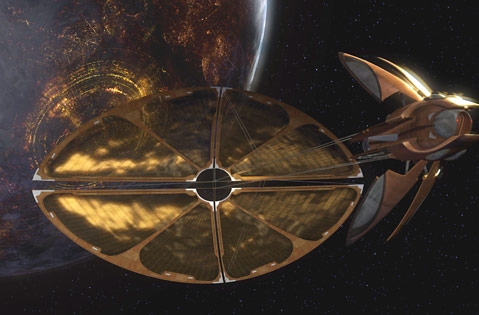
Putting the “Science” in “Science Fiction” – Space Travel 3: Other Potential Engines
In the previous two blogs in this series, I examined ion engines and plasma engines – two technologies that have a great deal of potential for powering the spacecraft of the future. Although these two engine types attract a great deal of attention and research, a wide range of other possibilities are being explored for propelling vehicles through space. Throughout the history of space exploration, these concepts ranged from the straight-forward to the bizarre, and include spacecraft that are propelled by lasers, giant sails and even nuclear bombs. Other technologies have been examined, and it is likely that many new ones will be invented as the quest to explore outer space continues, but even these outlandish-seeming ideas are still being considered for use.

One possibility for spacecraft propulsion that is under consideration is laser propulsion, and many different ideas have been proposed as to how a laser-powered engine would work. Many of these ideas use a laser to ignite conventional fuel or create thrust by slowly disintegrating a solid block of material to use the resulting material for thrust, but other ideas are very different from conventional engines. One method uses a laser beamed from an outside source onto a vehicle, called a lightcraft. The lightcraft’s shape focuses the beam towards the craft’s base, where it ignites either air (in the atmosphere) or a fuel mixture (in a vacuum) and uses the resulting explosion to provide thrust. The lightcraft concept has a great deal of promise for launching vehicles into orbit, but less for propelling craft through space, since it will still need to carry fuel to ignite.
Another proposal for a laser-powered spacecraft is called the Photonic Laser Thruster, a system which bounces a laser beam between mirrors within a spacecraft or mounted on two nearby spacecraft in order to amplify the beam’s power enough to provide thrust. This system, if successfully tested, could provide a capacity for precisely maneuvering and creating tight formations of spacecraft far beyond conventional systems. Another advantage of any of these systems is that they use well-understood and currently available laser technology, instead of experimental ion, plasma or fusion systems.

Another surprising use of tried-and-true technology is the possibility of propelling spacecraft with sails. These sails would not rely on wind as sailing ships do, but would instead use light or the solar wind to provide momentum. Once a solar sailing craft was out of orbit, it would deploy massive sails, between 800 meters and 15 kilometers in size, with the average estimate being one kilometer. These sails would be made of incredibly thin and lightweight materials, and would propel the spacecraft through the pressure exerted by the light of the sun. These craft could reach very high velocities given time: a small unmanned experimental craft called IKAROS flew from Earth to Venus in seven months using a solar sail only 20 meters across.
In comparison, a rocket-powered satellite made the trip in half the time, showing that the gap between the two methods of propulsion is closing rapidly. Solar sails could also be accelerated by using a large laser array on an orbital station or planet, speeding them on their way.
Another method of space sailing uses a magnetic sail, formed from electrically-charged cables, to deflect the charged particles and plasma ejected by the sun in order to provide propulsion. These sails could be much lighter than solar sails, as they are simply wires instead of a complete sail, but would have to be much larger to capture the smaller amount of energy found in the solar wind.
Another possibility that is currently undergoing analysis is a system that uses a powerful magnetic coil and plasma to create a magnetically-charged plasma bubble around the spacecraft that would work like a sail without requiring the physical structure of one. This system is still experimental, however, and will still take a great deal of research and development before actual testing can begin. Although the idea of a sail-powered spacecraft is strange, it seems to be highly efficient and feasible, with other ideas for spacecraft propulsion being even stranger.

Another idea for propelling spacecraft that appeared in the 1950s-60s seems even more bizarre, though it is workable. This idea, called nuclear pulse propulsion, uses a series of nuclear explosions to propel the spacecraft forward. The first version of this design, called Project Orion, launched small directionalized nuclear explosives out the rear of the ship. The explosion would push against a reinforced plate at the ship’s rear and propel it forwards at speeds far in excess of current chemical rockets. A proposed round trip from Earth to Mars would take only four weeks, rather than the 12 months a modern rocket would take. There were many concerns with the system, including concerns about the nuclear fallout caused by launching such a craft, and the Partial Test Ban Treaty ended the project by making nuclear weapons tests in the atmosphere and outer space illegal. So Project Daedalus was proposed, using a similar design and more advanced systems to create and guide fusion reactions, but the technology required is beyond current capabilities.
Another proposed design, known as Project Medusa, worked in a similar way to Daedalus, but launched the nuclear explosive forwards and caught the detonation in a large sail, pulling the craft along instead of pushing it.
Although there is a great deal of potential for these designs, the dangers inherent in nuclear explosions and the legal issues regarding them will likely prevent them from ever making it into development – unless there is an immediate and dire need for them.
Numerous technologies have been proposed for propelling spacecraft, and it is likely that many more will be attempted before a system appears that combines efficiency, speed and cost into a package that makes space travel truly feasible. Although difficulties abound, the human drive to explore and expand will continue to push scientists and inventors to attempt to create the perfect craft to conquer the Final Frontier.
Top Photo: nl.starwars.wikia.com













